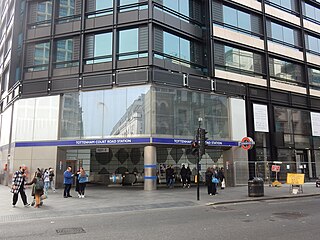
Tottenham Court Road is a London Underground and Elizabeth line station in St Giles in the West End of London. The London Underground station is served by the Central and Northern lines. On the Central line it is between Oxford Circus and Holborn stations, and on the Charing Cross branch of the Northern line it is between Goodge Street and Leicester Square stations. The station is located at St Giles Circus, the junction of Tottenham Court Road, Oxford Street, New Oxford Street and Charing Cross Road and is in Travelcard Zone 1, with a second entrance at Dean Street.

Aldgate was a gate in the former defensive wall around the City of London.
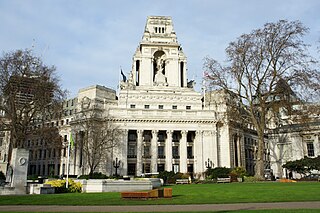
Tower Hill is the area surrounding the Tower of London in the London Borough of Tower Hamlets. It is infamous for the public execution of high status prisoners from the late 14th to the mid 18th century. The execution site on the higher ground north-west of the Tower of London moat is now occupied by Trinity Square Gardens.

Fenchurch Street is a street in London, England, linking Aldgate at its eastern end with Lombard Street and Gracechurch Street in the west. It is a well-known thoroughfare in the City of London financial district and is the site of many corporate offices and headquarters. The name "Fenchurch" means "church in the fenny or marshy ground" and presumably refers to St Gabriel Fenchurch, which stood at the junction of Fenchurch Street and Cullum Street until it was destroyed by the Great Fire.
The EC postcode area, also known as the London EC postal area, is a group of postcode districts in central London, England. It includes almost all of the City of London and parts of the London boroughs of Islington, Camden, Hackney, Tower Hamlets and Westminster. The area covered is of very high density development. Deliveries for the EC postcode area are made from Mount Pleasant Mail Centre.

Gropecunt Lane was a street name found in English towns and cities during the Middle Ages, believed to be a reference to the prostitution centred on those areas; it was normal practice for a medieval street name to reflect the street's function or the economic activity taking place within it. Gropecunt, the earliest known use of which is in about 1230, appears to have been derived as a compound of the words grope and cunt. Streets with that name were often in the busiest parts of medieval towns and cities, and at least one appears to have been an important thoroughfare.
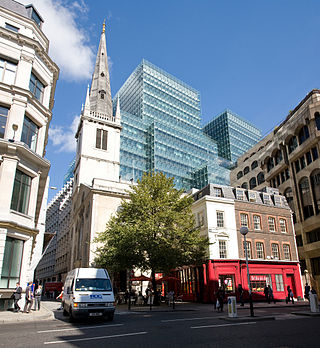
30 Fenchurch Street is one of the largest office developments in the City of London, the primary financial district of London. Until October 2020, the building was known as Plantation Place, taking its name from a previous Plantation House, once the world's recognised centre of the tea trade.

East India House was the London headquarters of the East India Company, from which much of British India was governed until the British government took control of the company's possessions in India in 1858. It was located in Leadenhall Street in the City of London. The first East India House on the site was an Elizabethan mansion, previously known as Craven House, which the Company first occupied in 1648. This was completely rebuilt in 1726–29; and further remodelled and extended in 1796–1800. It was demolished in 1861. The Lloyd's building, headquarters for Lloyd's of London, was built on the site of the former East India House.

The Thirteen Factories, also known as the Canton Factories, was a neighbourhood along the Pearl River in southwestern Guangzhou (Canton) in the Qing Empire from c. 1684 to 1856 around modern day Xiguan, in Guangzhou's Liwan District. These warehouses and stores were the principal and sole legal site of most Western trade with China from 1757 to 1842. The factories were destroyed by fire in 1822 by accident, in 1841 amid the First Opium War, and in 1856 at the onset of the Second Opium War. The factories' importance diminished after the opening of the treaty ports and the end of the Canton System under the terms of the 1842 Anglo-Chinese Treaty of Nanking. After the Second Opium War, the factories were not rebuilt at their former site south of Guangzhou's old walled city but moved, first to Henan Island across the Pearl River and then to Shamian Island south of Guangzhou's western suburbs. Their former site is now part of Guangzhou Cultural Park.

Gray's Inn Road is an important road in Central London, located in the London Borough of Camden. The road begins at its junction with Holborn at the City of London boundary, passes north through the Holborn and King's Cross districts and terminates at King's Cross railway station. It is designated as part of the A5200 road.

20 Fenchurch Street is a commercial skyscraper in London that takes its name from its address on Fenchurch Street, in the historic City of London financial district. It has been nicknamed "The Walkie-Talkie" because of its distinctive shape, said to resemble a walkie-talkie handset. Construction was completed in spring 2014, and the three-floor "sky garden" was opened in January 2015. The 38-storey building is 160 m (525 ft) tall. Since July 2017, the building has been owned by Lee Kum Kee Groups.
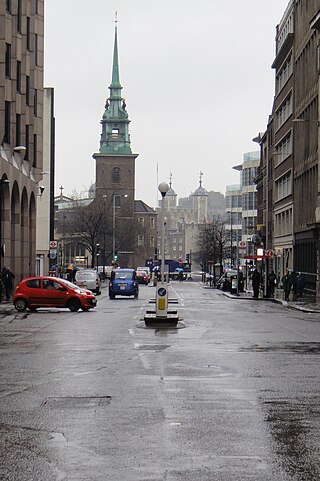
Great Tower Street, originally known just as Tower Street, is a street in the City of London, the historic nucleus and modern financial centre of London, England. It forms an eastern continuation of Eastcheap starting at Idol Lane, and leads towards Byward Street and Tower Hill. On Byward Street, opposite Great Tower Street, is the historic church All Hallows-by-the-Tower.

St Gabriel Fenchurch was a parish church in the Langbourn Ward of the City of London, destroyed in the Great Fire of London and not rebuilt.

Byward Street is a road in the City of London, the historic and financial centre of London. It forms part of the A3211 route and, if travelling eastward, is a short continuation of Lower Thames Street from a junction with Great Tower Street, to Tower Hill. It is located within the City ward of Tower.
Monkhouse Davison (1713–1793) was the senior partner in one of the leading grocers in 18th century London, Davison Newman and Co., that imported a wide range of produce including tea, coffee, sugar and spices. The company is best known today for the disposal of chests of its tea in the Boston Tea Party at the start of the American Revolution. Products branded with the company name are still being sold, over 360 years after its foundation.

Plantation Place South is an office building in the City of London. It consists of nine floors and forms part of a complex consisting of the larger 30 Fenchurch Street to the north. The building was designed by the Arup Associates architects' group. Plantation Place South was first proposed as a new area of office development in 2001 and construction work began in 2002; it was completed and opened two years later.

Mark Lane is a street in the City of London linking Great Tower Street and Fenchurch Street. It gave its name to the nearby Mark Lane tube station, which was opened in 1884, renamed Tower Hill in 1964, and closed three years later. For some 240 years, Mark Lane was known for the corn exchange ; it occupied a series of properties on the east side of the southern end of the street.
The London Tea Auction was a candle auction of tea, that ran regularly for over 300 years from 1679 until its closure on 29 June 1998. The auction made London the centre for tea's international trade. The East India Company held the first auction in Leadenhall Street and then in 1834 - after the East India Company ceased to be a commercial enterprise - the auction was held on Mincing Lane.
To the uninitiated a Tea sale appears to be a mere arena in which the comparative strength of the lungs of a portion of his Majesty´s subjects are to be tried. No one could for an instant suspect the real nature of the business for which the assemblage was congregated...
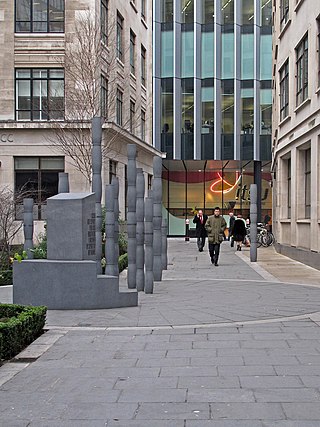
Fen Court is a short pedestrian passageway in the City of London, England, linking Fenchurch Street to Fenchurch Avenue.
This is a list of the etymology of street names in the City of London.


















